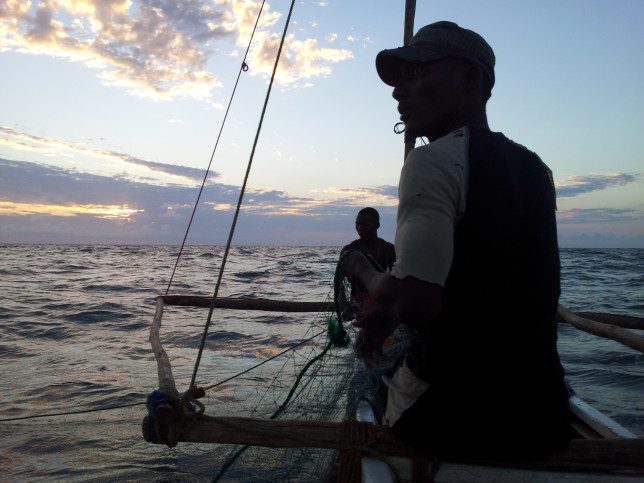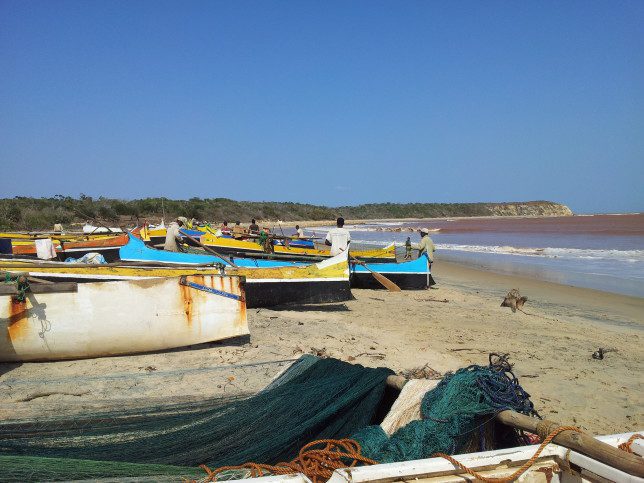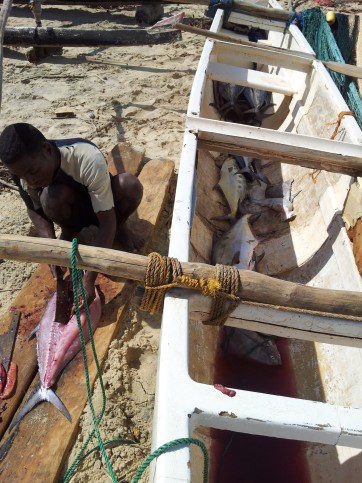by Cecile Fattebert, Barren Isles Conservation Officer, Madagascar
This summer I set foot in Madagascar for the first time in order to work with Blue Ventures, where we’re moving towards creating Madagascar’s largest protected area and the Indian Ocean’s largest community-run marine protected area around the Barren Isles. Maintirano is a very laid back town, where the roads are mostly sandy paths or permanently covered by dust (which gets everywhere!) and even during the regular power cuts retains its aura of calm. The Barren Isles, located west of Maintirano in the Mozambique Channel, form a remarkable archipelago, astonishing in several regards. They are home to some amazing wildlife such as humpback whales, dolphins, sharks and turtles (to name but a few), and some of the most diverse and healthiest coral reefs in the western Indian Ocean can be found here.
One Saturday morning at the crack of dawn (not too long ago), I left to go on a fishing trip with three local men, two of whom work with us on our shark and turtle monitoring projects. The traditional sailing pirogue took us to Nosy Marify, the closest island to Maintirano, where we were going to meet some fishers and see what they were catching. Shark populations around the Barren Isles are becoming overexploited and most fishers recognise that the size of their catch (no matter what’s in the net) is diminishing. They use ZDZD nets (large holed nets 100m long and 2-3m wide, attached with floats on the top and weights on the bottom to stand straight in the water), which catch pregnant, juvenile, and adult sharks alike – one of the factors in shark declines in the area. But the main driver for the reduction in shark numbers is the demand for shark fin from China, where the fins are used in the infamous shark fin soup.

Mastata and his son laying out nets in the evening light
Nosy Marify is said to be a hotspot for shark fishing, though none of the fishers landed a shark during my visit, despite having laid out their nets overnight. An observation that speaks loudly about the status of the fishery, and shark populations in the vicinity.
Madame Tity, the charismatic president of the UPTM (Traditional Fishers Union of Maintirano), approached me while I was on the island and was very keen to talk – she introduced me to her son Mastata and grandson who are both fishers. Madame Tity knew that I wanted to see more shark fishing and decided that I would go with them to fish with ZDZD nets on the open sea.
On the way to the fishing spot we tried to talk, and though much of what was said was lost in translation, I still managed to understand Mastata when he explained that their main problem was that they had no way to sell fresh tuna in Maintirano and so have to resort to selling shark fins for extra income. Tuna is worth 10,000 Ariary (Ar) per kilogram, or 6,000 Ar per kilogram when sold to a collector, compared to 3,000 Ar when salted and dried – which is the only option for most fishers to keep the meat edible. Shark fins however, are sold for next to nothing, and sometimes the fishers are given as little as 1000 Ar per fin. Fishing is so important to them that they even go out during the cyclone season, doing their best to stay safe despite the conditions.

The lonely beach where we ended up after our night’s fishing
At sunset, the fishers put out their nets and at 7 or 8pm we were done and settled down for the night on the boat. The sea was rough and the wind kept blowing strongly but the stars were bright. and it was strangely peaceful on the water. We laid down for the night, our legs folded and wrapped up in the sail. The fishers would intermittently exchange some words, words that would sounded like isolated pearls of voices in the immensity of the ocean. We were all wet, constantly splashed by the ever crashing waves. Surprisingly, despite the fact that everything was damp, the sail was sturdy and protected us from the brunt of the wind and the worst of the waves. Not only are these sails the backbone of the fishers’ livelihoods, but also they also offer shelter and protection while waiting for the morning to arrive.
Morning came, and the “maso andro” (that’s the sun to you and me) rose over the horizon, a majestic ball of red fire. The fishers pulled in their nets. The catch was quite good in my opinion, but still less than the day before when they caught 51 tuna.
The fishers then prepared the sails, mounting the mast, with surprising agility and strength, for the sea was still rough and the wind had not weakened. After a while, I understood we would not be heading back to Nosy Marify, as the strong southern wind had blown us nearly 30km north of Maintirano, to a sandy long beach. A few tiny fishers’ houses were settled there, completely isolated. There wasn’t even a road to link them to Maintirano, the closest town of any notable size.

Mastata cleaning his tuna before laying them out to dry them in the sun
Now back on dry land, the fishers’ most pressing issue was the lack of salt to cure their catch, so they cleaned the tuna and let them dry in the sun – exchanging the smaller fish for rice, bananas, and the possibility of cooking with one of the families living nearby later on. Some of the fishers decided to stay behind to mind the boats, while I headed to Maintirano on foot with the rest of the group.
Thus began a seemingly endless walk on inland trails, where we went through bushes, crossed a pond and (surprisingly) met family members of Zakaly, one of the fishers I was walking with. The fishers chatted amiably, despite the gruelling pace, carrying their catch on sticks in order to dry it. Just a day in the life, I supposed… Wrongly as I later learned, as it had been the first time for them to experience such a strong southern wind and they had never been blown so far north before.
This encounter gave me a precious insight into life on these islands; how the communities cope with unpredictable weather, and the related food shortages (the fishers stayed on the northern beach for three days, with nothing but a bit of rice, water and cassava). But it also raised questions, such as how to avoid catching juvenile sharks when tuna is what’s being really targeted. But above all, the experience strengthened my conviction that by managing fisheries well, you help both the environment and the people who depend on them.
We would like to thank our funders for their support, including: the GEF through UNEP under the Dugong and Seagrass Project, the Critical Ecosystem Partnership Fund and the Darwin Initiative through UK Government funding.

